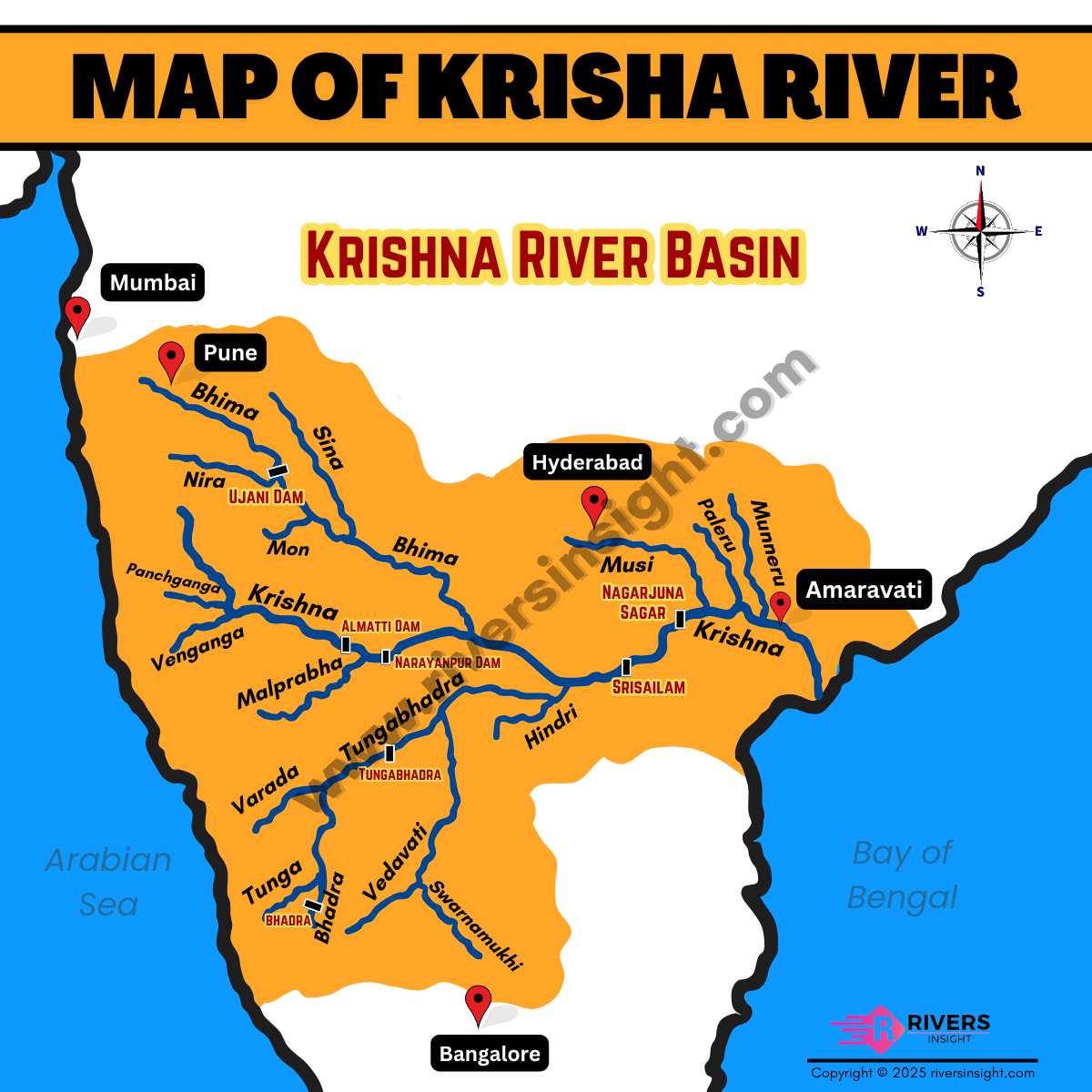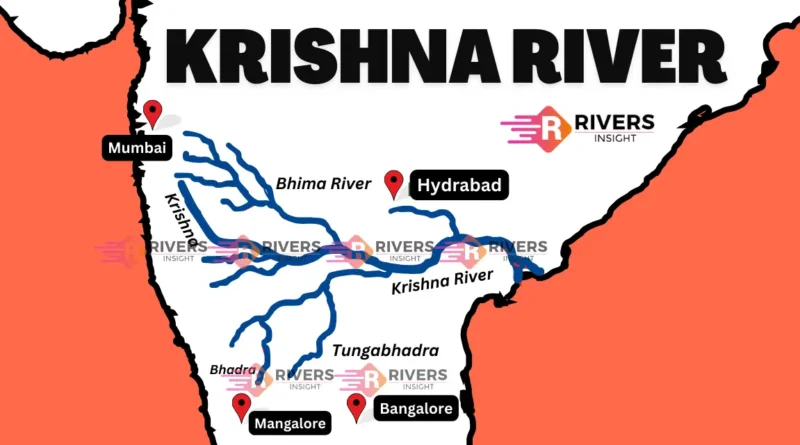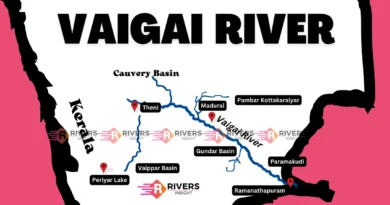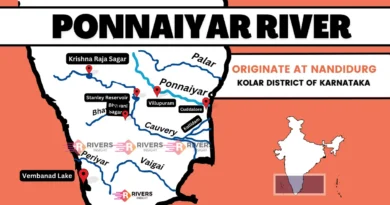Krishna River System: Map, Dams, and Tributaries
The Krishna River is a major river in India and is a prominent geographical feature that originates from the Western Ghats in the state of Maharashtra. It meanders through the states of Karnataka, Telangana, and Andhra Pradesh before finally merging with the Bay of Bengal.
This article will explore the Krishna River system, covering its geographical features. Moreover, we’ll discuss aspects such as a map of the Krishna River in India, tributaries on the left and right banks, dams, and more to understand why the Krishna River system is important.
| River | Krishna |
| Origin | Mahabaleshwar |
| Length | 1400km |
| Area | 258,948 square kilometers |
| Tributaries | Tungabhadra, Bhima, Mallaprabha, Ghataprabha, Yerla, Warna, and Dindi rivers |
| Which states | Maharashtra Karnataka Telangana Andhra Pradesh |
Table of Contents
Krishna River System
The Krishna River, India’s fourth-largest river by water inflows and basin area after the Ganga, Godavari, and Brahmaputra, stretches approximately 1400 km. As the Peninsula’s second-largest east-flowing river, it holds considerable hydrological importance. Further, its basin covers about 258,948 square kilometers, and during the monsoon season, it sees a substantial surge in discharge, averaging around 3500 m³/s.
The Krishna River flows through four Indian states:
- Maharashtra
- Karnataka
- Telangana
- Andhra Pradesh
Origin & Course of River Krishna
Krishna River originates at Mahabaleshwar with an elevation of 1336 m near Jor village in the northernmost part of Satara district, Maharashtra. It flows eastward, traversing through different regions before ultimately reaching the Bay of Bengal in Andhra Pradesh. Along its course, the river passes through major cities such as:
- Mahabaleshwar
- Sangli
- Vijayawada
- Satara
- Pune
- Solapur
- Guntur
- Machilipatnam
Map of Krishna River with Dams & Tributaries

Drainage Basin
The Krishna Basin extends over an area of 258,948 km2), which is nearly 8% of the country’s total geographical area. This large basin lies in the states of Karnataka, Telangana, Andhra Pradesh, and Maharashtra. Here’s the breakdown by state:
- Karnataka: 113,271 km2
- Telangana, Andhra Pradesh: 76,252 km2
- Maharashtra: 69,425 km2
Waterfalls
The Krishna River and its tributaries create many beautiful waterfalls such as:
- Gokak Falls
- Kalhati Falls
- Theertham Falls
- Manikyadhara Falls
- Hampi Waterfall (formed by the Tungabhadra River)
- Magod Falls (in the Yellapur taluk of North Canara district)
Tributaries of Krishna River
The Krishna River receives water from numerous tributaries originating from the Western Ghats and the Deccan Plateau. Major tributaries include the Tungabhadra, Bhima, Mallaprabha, Ghataprabha, Yerla, Warna, and Dindi rivers. Here’s a breakdown of some key tributaries and their features:
Right Bank Tributaries
- Tungabhadra River: Originating in Karnataka’s Western Ghats, it joins the Krishna in Andhra Pradesh. About 531 km long, it irrigates an area of about 71,417 square kilometers.
- Malaprabha River: Starting from Karnataka’s Western Ghats, it meets the Krishna near Bailhongal. Around 304 km long, it sustains biodiversity over an area of about 20,000 square kilometers.
- Ghataprabha River: Emerging from Karnataka’s Western Ghats, it flows to join the Krishna near Gokak. Approximately 283 km long, it supports agriculture over an area of about 8,829 square kilometers.
- Panchganga River: Formed by five rivers in Maharashtra, it merges with the Krishna near Karad. About 111 km long, it holds cultural significance over an area of about 6,444 square kilometers.
- Warna River: Originating in Maharashtra, it joins the Krishna near Karad. Spanning around 155 km, it enriches historical sites over an area of about 1,580 square kilometers.
- Koyna River: Originating in Maharashtra, it merges with the Krishna near Karad. Roughly 130 km long, it contributes to hydroelectric power over an area of about 6,024 square kilometers.
Left Bank Tributaries
- Bhima River: Bhima river originates in Maharashtra’s Western Ghats, it joins the Krishna at Raichur. It’s about 725 km long, supporting agriculture over an area of about 70,614 square kilometers.
- Munneru River: Starting in Andhra Pradesh’s Eastern Ghats, it joins the Krishna near Nandigama. It’s about 144 km long and helps recharge groundwater over an area of about 3,422 square kilometers.
- Musi River: Beginning in Telangana’s Ananthagiri Hills, it merges with the Krishna near Vikarabad. It’s about 240 km long and is known for its scenic beauty, covering about 9,699 square kilometers.
- Dindi River: Originating in Andhra Pradesh’s Eastern Ghats, it joins the Krishna near Nandigama. It’s about 111 km long and helps maintain the river’s flow, supporting local wildlife over an area of about 2,382 square kilometers.
Dams
The table below provides a list of dams situated along the Krishna River system and its tributaries.
| Dam | River | Location |
|---|---|---|
| Almatti Dam | Krishna River | Karnataka |
| Narayanpur Dam | Krishna River | Telangana |
| Jurala Dam | Tungabhadra | Telangana |
| Srisailam Dam | Krishna River | Andhra Pradesh |
| Nagarjuna Sagar Dam | Krishna River | Telangana |
| Tungabhadra Dam | Tungabhadra | Karnataka |
So, in this article, we have covered comprehensive information about the Krishna River system, including its origin, major tributaries on both the left and right banks, as well as key features such as length, basin area, and notable dams along the river.
For further details or any queries, please feel free to ask in the comment box below.
FAQs
Where does the Krishna River originate from?
The Krishna River originates from the Western Ghats in the state of Maharashtra and flows through several states before emptying into the Bay of Bengal.
Which states does the Krishna River flow through?
The Krishna River flows through the states of Maharashtra, Karnataka, Telangana, and Andhra Pradesh.
What are the tributaries of the Krishna River?
The major tributaries of the Krishna River are Tungabhadra River, Koyyna River, Bhima River, Musi River, Paleru River, Munneru River, Haliya River, Dindi River, and Sabari River.





Excellent presentation